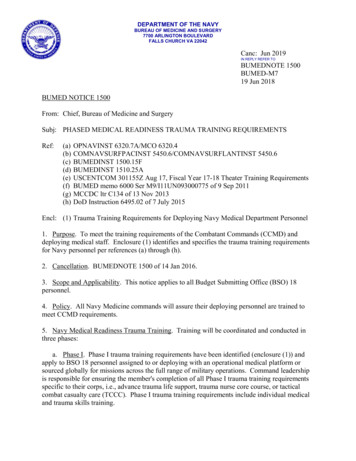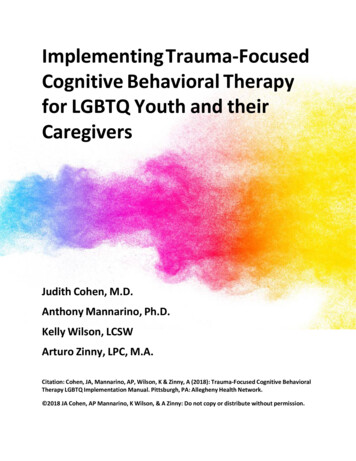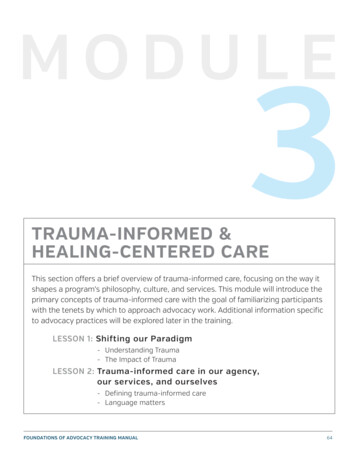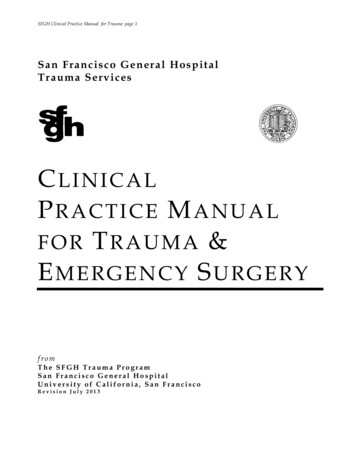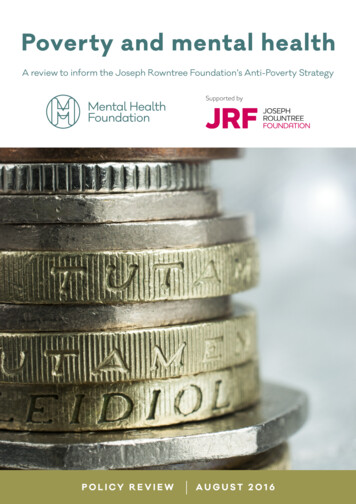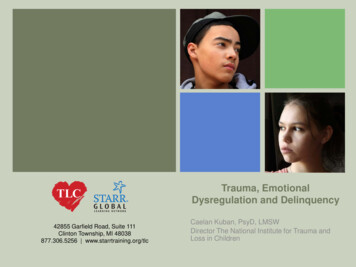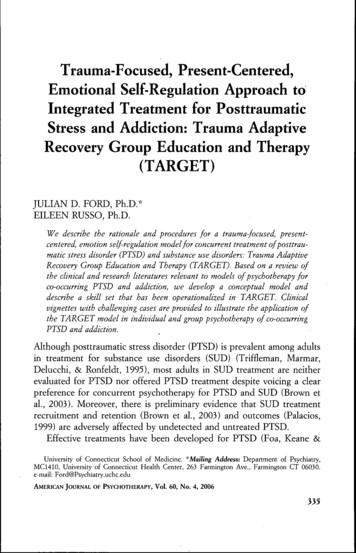
Transcription
Trauma-Focused, Present-Centered,Emotional Self-Regulation Approach toIntegrated Treatment for PosttraumaticStress and Addiction: Trauma AdaptiveRecovery Group Education and Therapy(TARGET)JULIAN D. FORD, Ph.D.*EILEEN RUSSO, Ph.D.We describe the rationale and procedures for a trauma-focused, presentcentered, emotion self-regulation model for concurrent treatment of posttraumatic stress disorder (PTSD) and substance use disorders: Trauma AdaptiveRecovery Group Education and Therapy (TARGET). Based on a review ofthe clinical and research literatures relevant to models of psychotherapy forco-occurring PTSD and addiction, we develop a conceptual model anddescribe a skill set that has been operationalized in TARGET. Clinicalvignettes with challenging cases are provided to illustrate the application ofthe TARGET model in individual and group psychotherapy of co-occurringPTSD and addiction.Although posttrautnatic stress disorder (PTSD) is prevalent among adultsin treatment for substance use disorders (SUD) (Triffleman, Marmar,Delucchi, & Ronfeidt, 1995), most adults in SUD treatment are neitherevaluated for PTSD nor offered PTSD treatment despite voicing a clearpreference for concurrent psychotherapy for PTSD and SUD (Brown etal., 2003). Moreover, there is preliminary evidence that SUD treatmentrecruitment and retention (Brown et al., 2003) and outcomes (Palacios,1999) are adversely affected by undetected and untreated PTSD.Effective treatments have been developed for PTSD (Eoa, Keane &University of Connecticut School of Medicine. Mailing Address: Department of Psychiatry,MC1410, University of Connecticut Health Center, 263 Farmington Ave., Farmington CT 06030.e-mail: Ford@Psychiatry.uchc.eduAMERICAN JOURNAL OF PSYCHOTHERAPY, Vol. 60, No. 4, 2006335
AMERICAN JOURNAL OF PSYCHOTHERAPYFriedman, 2001) and for addictions (Kadden, 1999). However, psychotherapy approaches for co-occurring PTSD and addiction are less welldeveloped. In this article, we will describe the complicated interactionbetween PTSD and addiction, and identify the primary objectives forconcurrent PTSD and addictions treatment. We will discuss the strengthsand limitations of extant approaches to PTSD and addiction treatment inrelation to each primary objective, and then describe the conceptual modeland skill set taught by a new treatment model—Trauma Adaptive Recovery Group Education and Therapy (TARGET)—in order to illustratepoints of complementarity with and departure from the alternative treatments. Finally, we wUl provide clinical examples to illustrate the application of TARGET.THE COMPLEX INTERACTION OF PTSD AND SUBSTANCEABUSE: IDENTIFYING TARGETS FOR TREATMENTThe diagnosis of PTSD formally involves three symptom-based criteria:intrusive reexperiencing (unwanted trauma memories, reminders, andflashbacks), avoidance of reminders of past trauma and emotional numbing, and hyperarousal and hypervigilance (American Psychiatric Association, 1994).The neurobiology of trauma and dissociation (Ford, 2005) provides auseful framework for understanding the interplay of these symptoms witheach other and with addiction. The alterations in brain chemicals believedto underlie PTSD tend to be similar to, or complementary with, theneurobiological alterations associated with SUD, including the dysregulation of key neurotransmitters (e.g., dopaijiine, serotonin, norepinephrine)and neuropeptides (e.g., glucocorticoids, neuropeptide Y, substance P) inthe body's central (brain) and peripheral (autonomic) nervous systems,which modulate stress reactivity (Jacobsen, Kosten, & Southwick, 2001).The core neurobiological alteration in PTSD is hyperarousal, a tendencyfor the brain and the body's nervous system to react in a rapid, extreme,and prolonged manner to stressors. In an attempt to modulate theseintense physiological reactions, the individual often draws upon adaptiveforms of anticipatory awareness (e.g., watchfulness for signs of externaldanger or bodily distress). If hyperarousal persists, the adaptive attempt toanticipate and prepare may escalate into a maladaptive preoccupation witheven mild or remote signs of threat or bodily distress {hypervigilance). Inorder to reduce hyperarousal and to sustain hypervigilance, avoidance ofpeople, places, activities, thoughts, emotions, or body sensations associatedwith threat or distress tends to occur. Avoidance is associated with severe336
Trauma Adaptive Recovery Group Education and Therapy (TARGET)difficulties with the recognition and expression of emotions {emotionalnumbing}, especially emotions involving intimacy, vulnerability, or trust inothers {social detachment). As a result, survivors become unable to processand integrate trauma memories, leading to being flooded with unwantedmemories {intrusive re-experiencing). When this persists the bodily dysregulation can lead the person to feel as if trauma is happening all overagain {flashhacks).Each of these features of PTSD can lead to substance use problems,including use of alcohol, street drugs, and prescription medications (Jacobsen et al., 2001; Triffleman, 2002). Exposure to trauma is not alonesufficient to lead to SUD, but PTSD may lead to SUD (or may cooccurwith SUD as a result of other factors, e.g., impulsivity, social isolation)(Breslau, 2003). Hyperarousal can lead to attempts to reduce anxiety andtension through self-medication, or on the other hand to the use ofstimulant drugs in order to maintain a state of high arousal. Hypervigilance,similarly, may be sustained by the use of drugs that artificially increase theability to maintain alert watchfulness. Psychoactive substances may beused to reduce the distress associated with intrusive reexperiencing and toprovide temporary forms of avoidance of traumatic memories and associated distress (i.e., self-medication). Emotional numbing and social detachment in PTSD may lead to the use of substances as a means of regainingthe ability to feel pleasure or connection to other people. Posttraumaticstress disorder also often involves dysphoria, impulsivity, and social isolation, each of which can lead to SUD.Moreover, SUD can exacerbate or complicate PTSD. Substances thatincrease or depress the body's arousal level and the interactive effects ofbrain neurotransmitters tend to directly or indirectly (e.g., through rebound effects) heighten hyperarousal and hypervigilance. Substances thathave mood altering effects can increase hypervigilance, emotional numbing, and social detachment by inducing states of persistent dysphoria oranxiety. Substances that alter information processing can interfere withplanful working memory and narrative autobiographical memory, thusleading to unwanted trauma memories that are fragmentary, confusing,and involuntary. The lifestyle associated with chronic SUD often includesengaging in activities and involvement with peer groups that increase therisk of exposure to traumatic stressors (e.g., violence, crime, abuse,accidents).The goals of psychotherapy for PTSD and SUD thus, while notidentical, are complementary. Increasing the ability to replace impulsivereactions with reflective reality-based decisions is critical to managing both337
AMERICAN JOURNAL OF PSYCHOTHERAPYintrusive trauma memories and the cravings for substances and automaticbehavior patterns that sustain addiction. In order to eschew avoidance(whether via substance use or other self-defeating behaviors) as a primarycoping strategy, the individual must have skills that enable her to modulateintense (e.g., hyperarousal, intrusive re-experiencing; cravings for substances) and diminished (e.g., emotional numbing; disregard for personalsafety and well-being) states of bodily and emotional activation. Planfuldecision making and effective emotion regulation require the ability toaccess long-term memory to draw upon past learning and short-termmemory to formulate and follow-through with timely and organizedimmediate choices.PSYCHOTHERAPY APPROACHES FOR PTSD AND ADDICTIONAlthough there is a strong evidence base to support the use of cognitivebehavior therapy (CBT) for treating PTSD, most studies of CBT for PTSDhave excluded individuals with active SUD, so the applicability of thisapproach to the concurrent treatment of SUD and PTSD remains to betested (Foa et al., 2000). Many people with co-occurring SUD and PTSDhave suffered victimization trauma in childhood as well as in adulthood(Triffleman et al., 1995). Treatment for PTSD resulting from child abusetrauma requires attention to basic self-regulatory deficits (Herman, 1992).Indeed, Tarrier et al. (1999) excluded CSA survivors from their study ofexposure and cognitive restructuring because of concern that these treatments would not address developmental sequelae. McDonagh-Coyle et al.(2005) found a high rate (43%) of premature dropout from an exposurebased therapy for adult survivors of childhood sexual abuse (the majorityof whom had lifetime SUD histories, although none were currently usingsubstances), but a low drop-out rate (5%) from a supportive socialproblem solving therapy—and comparable efficacy in reducing PTSD.However, when adult survivors of child abuse were provided with preparatory training in skills for affect management, CBT for PTSD was welltolerated and beneficial (Cloitre et al., 2002).Turner et al. (1996) cite persistent dysfunctional beliefs and associateddeficits in self-care skills as a complicating factor for the survivors of CSAwith PTSD: high initial levels of anger (Foa, Riggs, et aL, 1995), memoriesreflecting "mental defeat" or the absence of mental planning (Ehlers et al.,1998), an overall sense of alienation or permanent change following thetrauma (e.g., feeling permanently tainted or damaged (Ehlers et aL, 1998),and an inability to develop a coherent narrative recounting of traumaexperiences in PE (Foa, Molnar, & Cashman, 1995). On the positive side,338
Trauma Adaptive Recovery Group Education and Therapy (TARGET)participants in the McDonagh-Coyle et al. (2005) study who were able toexperience and modulate strong emotions in therapy had positive outcomes in both the CBT and problem-solving treatments. Thus psychotherapists must address longstanding beliefs and dysregulated emotions whentreating PTSD with survivors of childhood abuse. Interventions for theconcurrent treatment of PTSD and SUD have taken several approaches toaddressing this goal.PTSD AND SUD TREATMENTCognitive behavioral therapy only recently has been applied to PTSDwith individuals in recovery from addiction. For example, a 16-sessionintervention combining prolonged exposure and cognitive restructuringwith cocaine dependent adults reported promising results for completers,but a high (60 %) drop out rate (Brady, Dansky, Back, Foa, & Caroll,2001). A 12-week partial hospital group CBT intervention ("Transcend,"Donovan, Padin-Rivera & Kowaliw, 2001) reported clinically significantreductions in PTSD and alcohol and drug use that were maintained at 6and 12-month follow ups. Assisted Recovery Trauma and Substances(ARTS; Triffleman, 2002), a 20-week, one-to-one therapy that first provides 11 sessions of CBT focused on substance abstinence and then 29sessions of individualized and paced CBT for PTSD, resulted in similarimprovement in PTSD symptoms and superior attendance and abstinencecompared to CBT focused only on SUD.MODELS FOR CONCURRENTSeeking Safety (SS; Najavits, 2002) is a manualized group interventionfor women or adolescent girls with co-occurring PTSD and SUD thatteaches more than 80 "safe coping skills" organized in a curriculum inwhich each session covers a defined topic with a presentation by the groupleader and structured exercises to practice skills relevant to the topic (e.g.,understanding and managing PTSD symptoms, anger; or guilt). SeekingSafety does not include discussion of specific trauma memories, butteaches skills for managing traumatic stress symptoms as they impact onoverall life functioning and recovery from comorlbid SUD. In a study with27 women. Seeking Safety was comparable to relapse prevention andsuperior to addiction treatment as usual in reducing PTSD and SUDsymptom severity and was superior to both other interventions in improvement in anxiety, depression, hostility, suicidality, and interpersonal problems (Najavits, 2002).Trauma Recovery and Empowerment Model (TREM; Harris & Fallot,2001) is an educational group intervention (like Seeking Safety) for womenor men with co-occurring major mental iLlness, SUD, and PTSD, focusing339
AMERICAN JOURNAL OF PSYCHOTHERAPYparticularly on the cumulative effects of living with poverty and stigmafollowing victimization trauma. Trauma Recovery and EmpowermentModel is manualized, with versions ranging from a 4-session introductionto a 24-33 session group. Initially, TREM focuses on skills and knowledgefor personal and relational awareness to address arrests in psychosexualdevelopment, and it provides a supportive (gender-separated) group milieu in which each survivor can disclose memories of trauma and overcomefear, grief, and shame in the form of telling her life story.A recent multisite study of multicomponent treatment models forwomen with co-occurring psychiatric and addictive disorders and historiesof exposure to violence included Seeking Safety and TREM at several sites.While no model-specific findings supported either approach specifically inrelation to a usual care condition, "small but statistically significant"benefits were found in PTSD and mental health symptom reduction whenthe results were aggregated for both of these integrated PTSD/SUDpsychotherapy approaches across all sites and interventions (Morrissey,Jackson, Ellis, Amaro, Brown, & Najavjts, 2005, p. 1213). Despite differences in these models, their common focus on the psychotherapeuticresolution of both PTSD and SUD in women's current lives provedeffective.PTSD ANDSUDSeveral conceptual and technical features distinguish the evolvingtreatment models for co-occurring PTSD And SUD.Cognitive Behavioral Therapy approaches focus on reducing anxietyand avoidance related to trauma memories (Foa & Kozak, 1998), andemphasize correcting dysfunctional cognitions to reduce intrusive symptoms of reexperiencing, emotional numbing, hyperarousal, and hypervigilance. (Brady et al., 2001; Donovan et aL, 2001; Mueser et aL, 2002;Najavits, 2002; Triffleman, 2002). Although CBT theorists recognize thatmaladaptive information processing must be dealt with to modify maladaptive beliefs (Brewin & Holmes, 2003; Foa & Kozak, 1998), a systematicapproach to enhancing information processing for PTSD or PTSD/SUDhave not developed for CBT interventions.Other approaches to PTSD therapy emphasize helping survivors regain"authority over the remembering process" (Harvey, 1996, p. 11) andregaining a sense of trust in themselves and in healthy relationships (Harris& Fallot, 2001; Herman, 1992) by telling their personal story (or narrative)and thereby "making meaning out of trauma" (Harvey, 1996, p. 13). TheKEY DIFFERENCES AMONG TREATMENT MODELS FOR CO-OCCURRING340
Trauma Adaptive Recovery Group Education and Therapy (TARGET)goal is not to reduce avoidance or to extinguish maladaptive fear (as inCBT), but to develop or regain a sense of empowerment, personal identityand worth, secure involvement in healthy relationships, and realisticsatisfaction in life and hope for the future. Similar to some CBT models(skills training in affective and interpersonal regulation with prolongedexposure [STAIR-PE], Seeking Safety), these self/relational approachesbegin by helping clients learn or strengthen skiLls for healthy bodilyself-care and psychological and relational safety. Cognitive BehavioralTherapy models also aim to help clients create positive personal narratives,healthy relationships, and self-worth, but view these as a byproduct ofreducing anxiety, whereas self/relational models view narrative and selfactualization work as the means rather than the ends of reducing anxiety.However, self/relational models have not developed a systematic therapeutic protocol grounded in theory and research to guide therapists andclients in doing personal/trauma narrative work.Both CBT and the self/relational approaches to PTSD/SUD treatmentinclude interventions designed to enhance social problem solving skills andaffect regulation skills (Ford, Courtois, van der Hart, Nijenhuis, & Steele,2005). This is particularly important with survivors of early childhoodinterpersonal trauma who are at risk for extreme dysregulation of emotion(e.g., rage, despair, terror), information processing (e.g., severe dissociation), bodily functioning (e.g., debilitating somatization), and relationships(e.g., enmeshed or explosive) (Ford, 1999; van der Kolk et aL, 1996).Cognitive Behavioral Therapy focuses on helping clients identify andmanage their reactions to trauma-related triggers in their current lives(Sharkansky, Brief, Peirce, Meehan, & Mannix, 1999; Triffleman, 2002),and replacing maladaptive coping styles with effective problem solving andassertiveness skills (Donovan et aL, 2001; Najavits, 2002; Triffleman,2002). Self/relational models instead rely upon therapeutic activities designed to build self- awareness, self-esteem, personal boundaries, andhealthy intimacy (Harris & Fallot, 2001; Pearlman & Saakvitne, 1995).However, no PTSD/SUD model has explicated a systematic set of stepsthat clients can use to guide them in regulating intense emotions andsolving social problems while maintaining sobriety. AdditionaUy, none ofthese models provides a practical framework for understanding and formanaging trauma memories and affect dysregulation while also strengthening sobriety. The treatment to be described in this paper is based uponjust such an organizing framework, which was developed to build uponand extend the strong base provided by other models for concurrentpsychotherapy of SUD and PTSD.341
AMERICAN JOURNAL OF PSYCHOTHERAPYTRAUMA ADAPTIVE RECOVERY GROUP EDUCATION ANDTHERAPY (TARGET)Trauma adaptive recovery group education and therapy (TARGET) isa manualized group and one-to-one psychotherapy that provides education about the biological and behavioral underpinnings ofPTSD and SUD, guidance in applying an integrated set of information/emotion processing and self-regulation skills to current life experiences, and an experiential component through the development an autobiographical narrative that incorporates, but does not primarily focusupon, trauma, PTSD, and SUD. TARGET was flrst developed inprivate practice and community mental health settings for adults withco-occurring mental illness and PTSD. For this population it wasboth clinically indicated and feasible to deliver TARGET as a closedor open-ended treatment lasting between six months and severalyears. In order to match the logistics of SUD treatment, a briefer9-session TARGET version was developed and was found to beassociated with significantly better abstinence self-efflcacy than anenhanced treatment-as-usual condition in a randomized effectivenessstudy (Frisman, Ford, & Lin, 2005).TARGET'S ORGANIZING FRAMEWORKTARGET focuses each client's attention on the core values and hopesthat have been the basis for her lifelong project of evolving a personalidentity (i.e., self-definition, self-esteem, and self-efficacy) and meaningfuland worthwhile relationships. Intrusive trauma memories and hypervigilance are reframed as occurring not because the person did not copeadequately with trauma, but because the survivor coped so effectively thatnow she has an internal biological alarm system that is adjusted for traumabut not for ordinary living. Therefore, rather than attempting to have theclient become desensitized to intense emotions, or thinking more rationallyand relaxing instead of being hypervigilant when experiencing intrusivetrauma memories, the goal is for the client to learn ways to prepare for, andproductively process, current trauma reminders (internal and external) andhow to reset the body's survival alarm appropriately to current lifecircumstances.TARGET focuses on resilience by shifting clients' attention to themeaningful reactions, feelings, thoughts, goals, and choices that are occursimultaneously with SUD and PTSD symptoms. Each symptom involveseffort (even if it seems to be automatic) and skillful planning and action342
Trauma Adaptive Recovery Group Education and Therapy (TARGET)Table I.THE TARGET FREEDOM STEPS Focus — to reduce anxiety and increase mental alertnessRecognize — specific stress triggersEmotions — identify primary feelingsEvaluate — primary thoughts/self-statementsDefine — primary personal goal(s)Option — identify one choice that represents a successful step towardthe primary goal(s) that the individual actually accomplished during acurrent stressful experience Make a contribution — recognize how that option had the added benefitby reflecting the person's core values and made a difference in others'lives.(even if it has become an impulsive reaction). The goal of treatment is torediscover the personal goals, choices, and abilities that have been obscured by the problematic aspects of PTSD and SUD symptoms—not to"get rid of" the symptoms, or to simply "substitute" adaptive ways ofcoping, but to find and rebuild adaptive skills that the survivor possessesand values within her/himself. The goal is to validate strengths rather thanfocusing on failings or deficits, and to engage clients in a constructiveself-directed examination of the problematic aspects of symptoms. This isdone with a blend of empathic validation (i.e., identifying problematicsymptoms as "alarm" reactions in which the brain/body is attempting toprotect the person from potential threats, real or perceived, in automaticways that were adaptive in surviving trauma) and strengths-based, clientcentered reframing (i.e., exploring alternative choices that already existand reflect the person's fundamental core emotions, beliefs, goals, andvalues, but which are obscured by automatic "alarm" reactions).TARGET is organized around a skill sequence that is described by anacronym, FREEDOM, a mnemonic tool (see Table 1). The FREEDOMskill sequence mirrors the neurobiology of adaptive development (Ford,2005) and the three phases of PTSD treatment (Ford et al., 2005).Phase 1 involves stabilization and self-regulation via focusing ("E").Focusing is taught as a three-step process that can be done in a inatter ofseconds, but requires repeated practice to be well-rehearsed and availablewhen stress reactions are experienced. The three steps are summarized bythe familiar code for calls for help, SOS. The first "5" stands for Slowdown: pause, take a breath, clear your mind, and inhibit impulsive actions.The "O" stands for Orient: pay attention to what your five senses aretelling you about your body (especially healthy feelings) and your environ343
AMERICAN JOURNAL OF PSYCHOTHERAPYment (especially things/people that are interesting). The second "S" standsfor 5elf-check: clients learn to make rapid ratings of current stress andperceived personal control on two 10-point scales. The purpose of SOS isto provide a practical, easily recalled self-cue (or cue from other people,such as friends or counselors who can suggest doing an "SOS") thatinterrupts reactive/impulsive thinking and action and facilitates simplecognitive processing.Phase 2 includes trauma processing via Recognizing ("R") specifictriggers for "alarm" reactions and the "reactive" Emotions ("E"), andcognitive Evaluations ("E"), goal Definitions ("D"), and behavioral responses or Options ("O")—the "REEDO" in FREEDOM—in the contextof therapeutic examination of current life experiences, with past experiences (traumatic, as well as other, formative events or relationships) as abackground for meaning-making (Harvey, 1996) rather than as the principal focus. The TARGET framework is an easily understood, remembered, and utilized sequence of steps for information and emotion processing that incorporates the trauma-based processing of PTSD, butprincipally, it shifts the person's focus to more self-reflective processing. Inthis respect, TARGET is complementary with other skills-based psychoeducation models for PTSD (e.g., Cloitre et al., 2002; Resick et al., 2002),SUD (e.g., Kadden, 2001), co-occurring PTSD and SUD (e.g., Donovan etal., 2002; Mueser et al., 2002; Najavits, 2002), or related relational,behavioral, and characterological problems, such as Dialectic BehaviorTherapy ([DBT]; Linehan, 1993). Skills taught in these models, such asmindfulness and distress tolerance (Linehan, 1993), grounding (Najavits,2002), and abstinence violation management (Kadden, 1999), are potentially valuable tactics for managing urges, agitation, dysphoria, or riskyimpulses. The EREEDOM sequence additionally provides a systematicstep-by-step model for simultaneously addressing addiction and PTSDbased upon the research literature on the psychobiology of trauma andself-regulation (Eord, 2005). No claim is made that the EREEDOM stepsmap exactly onto the trauma survivor's neurobiology or affect/informationprocessing. However, the EREEDOM sequence provides an organizingtemplate that therapists and clients can use as a proactive sequentialapproach to deploying self-regulation, information processing, and relational skills, in order to simultaneously address PTSD and SUD by: (1)managing triggered stress reactions, and (2) enhancing the clarity ofthought, feeling, and relatedness.Phase 3 involves an extension of therapy by incorporating the learningfrom Phases 1 and 2 into work on the client's overarching lifestyle, values,344
Trauma Adaptive Recovery Group Education and Therapy (TARGET)goals, and plans. This is accomplished by revisiting the third through fifthEREEDOM steps and assisting the client in identifying alternatives to theand goal(s) that are what the client feels, thinks, and aims for in life whennot caught up in "alarm" reactions. This phase involves the carefulidentification of actions the client already is taking when experiencingtriggered "alarm" reactions that the client views as positive steps (howeverimperfect or partial) toward her main goals. Lastly, Phase 3 includesrepeated discussions of how, from the client's point of view (with guidancefrom the therapist or, in group therapy, from group members), she or heis making a contribution to the people and values that are most importantto her or him by taking those steps toward main goals.THE T A R G E T CLINICAL INTERVENTIONThere are three core therapeutic components in the TARGET clinicalintervention. The first is education, which provides a novel definition anddescription of PTSD as a biological change in the body's "alarm" systemthat occurs as the result of automatic and highly adaptive reactions to athreat to the individual's (or a significant other's) survival. The role of theperipheral (e.g., autonomic) and central (e.g., brain stem, limbic, anteriorcingulate, prefrontal cortex) nervous systems (Eord, 2005) in respondingto danger and in seeking pleasure and avoiding distress is illustrated withgraphics and metaphorical examples (e.g., subcortical neural circuits as thebrain's "alarm" and "reward" systems; limbic and prefrontal circuits as thebrain's "in box" and "decision-maker") that make the neurobiology ofPTSD and SUD accessible to laypersons. The concept of a biological"survival alarm" that becomes sensitized, and therefore highly reactive, towhat appear to be minor stressors or substance use cues/contexts ("triggers") helps participants to make sense of the varied symptoms of PTSD,SUD, and associated socioemotional problems (e.g., rage, panic, dysphoria, denial, dissociation). This helps clients relate to their own experiencein a reframed version that emphasizes that these normal reactions toabnormal circumstances are healthy survival adaptations that have becomehighly reactive due to trauma.With this introduction, clients (who typically have sketchy or superficial information about the nature, origins, and causes of the persistence ofPTSD and SUD symptoms) often become very interested in learning howthey can gain greater control over PTSD and SUD by better recognizingand managing the body's "alarm" reactions. Therefore, the second corecomponent in TARGET is the teaching and guided practice of theEREEDOM skill sequence for managing traumatic stress symptoms. The345
AMERICAN JOURNAL OF PSYCHOTHERAPYFREEDOM protocol incorporates basic safety and self-management skills(e.g., Najavits's [2002] "grounding" skills) in a teaching sequence thatbegins with these skills before focusing on trauma-related emotion processing and autobiographical reconstruction (Cloitre et al., 2002). TheFREEDOM model provides a practical template for reflective examinationof current stressful experiences with a self-monitoring to assist clients inrecognizing how the skills can "reset" the body's alarm system.The FREEDOM skill sequence is used primarily as a prototype forreexamining recent stressful experiences, but also, it can serve as a guidefor safely examining trauma memories. Trauma memory work is undertaken only if the memory is troubling the client currently and if the clientand clinician judge that a clearer and more organized understanding of thetraumatic event(s) and the antecedents and consequences will help theclient in coping with current stressors and symptoms. Trauma memoryrecollection and disclosure, therefore, is not an automatic or requiredcomponent in TARGET. It is an option pursued only at the client's behestand preferably after the FREEDOM skill sequence has been well learnedand extensively practiced in examining current sub-traumatic stressfulexperiences. The one exception to this rule is when a client feels floodedwith intrusive memories during an early TARGET session. This is not thenorm but occurs often enough to warrant clinical preparation. In this case,the TARGET therapist helps
with PTSD: high initial levels of anger (Foa, Riggs, et aL, 1995), memories reflecting "mental defeat" or the absence of mental planning (Ehlers et al., 1998), an overall sense of alienation or permanent change following the trauma (e.g., feeling permanently tainted or damaged (Ehlers et aL, 1998),



